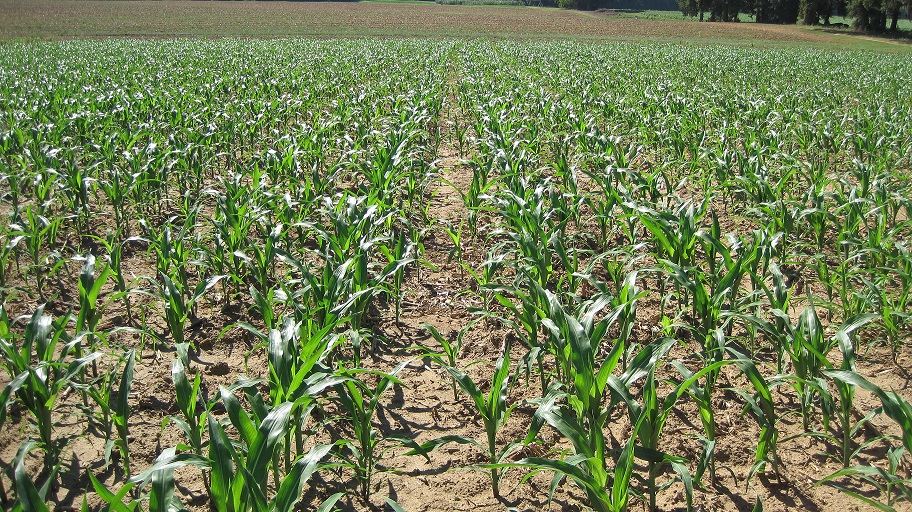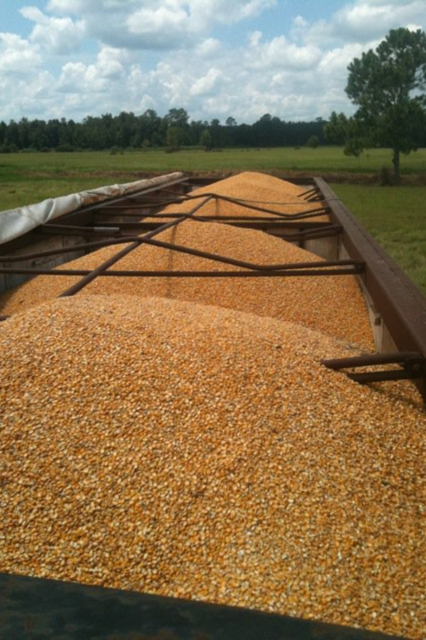
Attractive corn prices combined with reduced stocks will likely lead to an increase of planted acres across the U.S., including the Florida panhandle, in 2013. (Photo by Doug Mayo, Jackson Co. Extension)
Corn prices are attractive this year due to reduced corn stocks caused by the severe drought the corn-belt experienced in 2012. This will lead to an increase in corn acres across the US, including the Florida panhandle, where growers are concerned by projections of low peanut prices.
Growers who are considering planting corn this spring should immediately ask themselves 3 key questions: 1) Should I grow corn? 2) What hybrid do I plant? 3) When should I plant?
1.) Should I grow corn?
Twelve years of research from the University of Georgia has shown that dryland corn will yield 50% less than irrigated corn, on average. Therefore, access to irrigation is an important consideration when deciding whether or not to plant corn. In a good rainfall year, dryland corn can be profitable, however, in dry to average years, yields can be marginal on dryland fields.
Additionally, growers should consider where they will market their crop after harvest and what price they can receive for their crop. The current market conditions will likely cause a significant increase in corn acres this year, which could put pressure on local buying points. To determine the most profitable crops to grow in 2013, see the University of Georgia’s, Crop Profitability Comparison Tool.
2.) Which hybrid do I plant?
Deciding which hybrid to plant can be a daunting task for corn growers. There is a wide array of hybrids to choose from and many vary in yield potential, maturity, grain quality, lodging resistance, and disease resistance. It is important to select hybrids that are best suited for a particular field, in regards to its soil type and cropping history. Do your homework before buying seed. University of Georgia provides a guide describing the various corn genetic technologies and corn variety test results.

Research has consistently shown that, on average, early planted corn out-yields later planted corn. As plantings are delayed into the late spring, ¾ to 2 ½ bushels of yield are lost for every day of delay.(Photo by Adam Cook, Gilchrist Co.)
3.) When should I plant?
Corn should be planted as early as possible, provided weather and soil conditions are suitable. Research has consistently shown that, on average, early planted corn out-yields later planted corn. As plantings are delayed into the late spring, ¾ to 2 ½ bushels of yield are lost for every day of delay.
Suitable conditions for planting corn include at least 3 days of morning soil temperatures of 55 degrees or higher at a 2 in. depth, with forecasts of warming temperatures. For faster germination and emergence, delay planting until soil temperatures are 60 degrees. Emerged corn can usually withstand a hard frost as long as the growing point is under the soil surface (until about the V5 stage).
In addition to temperature considerations, corn should be planted into a moist seed bed at depth of 1 ½ to 2 in. for timely germination and emergence. For more information on planting and other production practices for corn, see the University of Florida’s, Field Corn Production Guide.
For additional information on corn production, contact your local UF/IFAS county extension agent.
- Carinata Starting to Come Up in Jackson County - December 12, 2014
- Wheat Production Considerations for 2014-2015 - November 10, 2014
- Peanut and Cotton Harvest Video 2014 - November 10, 2014
